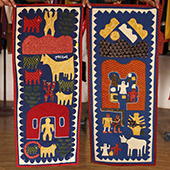Design Resource
Applique and Patchwork - Kutch, Gujarat
The Craft of Motifs on Textiles
by
Prof. Bibhudutta Baral and Rakshitha
The materials used for applique patchwork are usually cotton fabrics. The base textile is retained to be thin fabric compared to the fabric bits used for applique work. The minimum length of the applique patchwork is 3 metres and goes up to the length of the requirement of the customer. To fabricate an applique patchwork initially the base of the product has to be prepared. The base can either be a plane textile or a base prepared using patchwork. The artisan at Kutch prepares the base by patchwork. They initially decide on the design of it. The required size of the colored fabrics is cut into shapes needed for the pattern. All the cut pieces of fabric are laid on a flat surface to check the pattern. Once the pattern is set, pieces of fabric are sewn together facing inwards by creating the required form. Thus the base of the applique patchwork is made and ironed neatly.
In the next level applique work is carried out on the base textile prepared using patches of fabric. The motifs used for applique are trees, houses, and seasonal drawings representing the weather and environment during the summer, winter, rainy, spring and autumn seasons. Scenes from the mythological stories like Lord Krishna along with the dancers, narrative scenarios depicting festivals, farming, seasonal festivals like Raksha Bandhan, Navarathri celebration etc. As per the motif, the required patterned colored fabrics are cut. These pieces of desired cloth are arranged on the base textile initially as per the scenario narrated and then they are stitched on the base material with the help of a few rough stitches. Later the edges of these fabric bits are turned inwards and the motifs are completely hand stitched. The detailing of the motifs like the features of people, ornamentation etc is finely detailed further. As a final procedure, the artwork is neatly mounted with a border and sold.
The cost of the product differs according to the material of cloth used, designs made, work done to fabricate the product and the effort of the artisan put in. The work that narrates the whole scenario of a particular festival or occasion costs high. The number of days worked is calculated into hundred and the final product’s INR is fixed. For example, if the artisan works for three days to complete a single product then the product will cost INR300.









